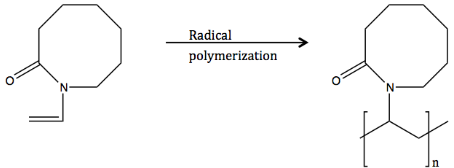Thermoresponsive polymers
Thermoresponsive polymers are of interest in several biological contexts such as tissue engineering and drug delivery. In particular, thermoresponsive polymers which have a cloud point (CP) in water that is close to body temperature (37 °C) are useful for these applications because they will precipitate their contents when they are inside the body. The cloud point of a polymer in a solution refers to the temperature at which it is no longer soluble and so it precipitates out and is dependent on the molecular weight, polydispersity index (PDI) and concentration of the solution.
The poly(N-vinyllactam) family contains a 5-membered ring, poly(N-vinylpyrodine) (PVP) (Figure 1), which has a CP above 100 °C. The 7-membered ring, poly(N-vinylcaprolactam) (PVCap) has a CP at 34-37 °C. This is close to body temperature which means it could be used in biomedical applications. The 6-membered ring, poly(N-vinylpiperidone) (PVPip), was recently found to have an intermediate CP which depends on molecular weight. Both PVCap and PVP have been polymerized using controlled radical techniques to afford well-defined polymers with controllable molecular weight and hence CP. It has been shown that PVPip can be synthesized by the RAFT mechanism (reverse-addition fragmentation chain transfer), which is a radical polymerisation technique that allows for polymers with a very small PDI to be made. It has also been shown that PVPip can be copolymerized with poly(vinyl acetate) (PVAc) which will undergo self assembly to form micelles. These micelles demonstrate reversible assembly and disassembly.

Figure 1. The poly(N-vinyllactam) family. On the left is PVP, the middle is PVPip and on the right is PVCap.
The final vinyllactam in the series is vinylazacyclo-octanone (VAco) (Figure 2), the eight membered ring analogue which is predicted to have a low CP. This project showed for the first time the polymerization of VAco to form poly(N-vinylazacyclo-octanone) (PVAco) which had a lower CP than its 5, 6 and 7 membered ring analogues. It also showed hysteresis which the 5, 6, and 7-membered ring polymers did not. It may now be possible to copolymerize VAco with vinyl acetate to tune its CP. It may also possible to make mixtures of these poly(vinyl lactams) to form a solution which may have an intermediate CP of the CPs of the two polymers.

Figure 2. VACo can be polymerised to form PVAco
This project was supervised by Dr.Cecilia Ieong in the group of Professor Rachel O'Reilly.
Reference: Ieong, N. S.; Redhead, M.; Bosquillon, C.; Alexander, C.; Kelland, M.; O’Reilly, R. K. Macromolecules 2011, 44, 886-893
